Cesarean scar pregnancy diagnosis and management
This rare but dangerous complication may lead to loss of the uterus if misdiagnosed.

Dr Timor-Tritsch is Professor of Obstetrics and Gynecology at New York University School of Medicine and Director of Ob/Gyn Ultrasound in the Department of Obstetrics and Gynecology, New York University School of Medicine, New York, New York.

Dr Monteagudo is Professor of Obstetrics and Gynecology at New York University School of Medicine and MFM Associate at Carnegie Hill Imaging, New York, New York.

Dr Kaelin Agten is a Research Fellow in the Division of Obstetrical and Gynecological Ultrasound, New York University School of Medicine, New York, New York.
None of the authors has a conflict of interest to report in respect to the content of this article.
A 27-year-old G3P011 with one previous cesarean delivery was referred for vaginal bleeding from an outpatient facility where a radiologist, based upon a transabdominal ultrasound scan, reported a “missed abortion” at 9 weeks and some concern for a cesarean scar pregnancy (CSP). On transvaginal ultrasound (TVS) done by the ob/gyn resident, an intrauterine pregnancy was diagnosed that was consistent with dates without fetal heart beats and with evidence of a retroplacental hematoma. The patient’s hematocrit was 11g/dL.
A D&C was performed due to active bleeding with an estimated blood loss of 1000 mL. A repeat transvaginal scan showed “ballooning of the lower uterine segment” but no evidence of perforation. The bleeding was unresponsive to tamponade by Foley balloon catheter inflated high in the cavity and “medical measures.” A repeat D&C was performed also without abatement of bleeding, now estimated at 2000 mL. An exploratory laparotomy was initiated, during which a normal-appearing anterior uterus and a ballooning lower posterior uterine segment with an area of dusky discoloration were noted.
Heavy vaginal bleeding was still noted, which led to a total abdominal hysterectomy. Intraoperatively the patient received 3 units of packed red blood cells and 1 unit of fresh frozen plasma. An arterial line was placed and her intraoperative vital signs stabilized. She received additional blood products but was discharged on postoperative day 2 in stable condition with normal blood pressure and heart rate. The pathologist first reported a cervical ectopic pregnancy. However, after a re-reading by a senior pathologist, the diagnosis was changed to a CSP.
CSP is a serious, iatrogenic consequence of a previous cesarean delivery. Unrecognized or left untreated, CSP can lead to clinical complications in all 3 trimesters of pregnancy. The above case is an example of how a misdiagnosis can lead to loss of the uterus. The rising incidence of CSP parallels the increasing rate of cesarean deliveries as well as that of morbidly adherent placenta. A CSP arises if a blastocyst implants in a microscopic or macroscopic tract on the uterine scar or in a niche or dehiscence left behind by the previous cesarean delivery.1
History
In the United States, cesarean deliveries increased steadily from 5% in 1970 to 32.9% in 2009.2,3 Recently, a leveling off of cesarean delivery rates has been reported.3 Unfortunately, CSPs are often misdiagnosed as “abortions in progress,” “ectopic pregnancies,” and “cervical pregnancies.” When the usual treatments such as D&C and systemic methotrexate (MTX) are used, profuse vaginal bleeding can be stopped only by hysterectomy.5 We have reported a complication rate of 44.1%,5 mainly secondary to missed diagnoses and potentially inappropriate treatments that caused heavy bleeding. In our series, there were 76 emergency laparotomies, 36 hysterectomies, 22 primary uterine artery embolizations (UAE), 49 secondary UAEs, as well as 14 laparotomies, and 3 hysterectomies, performed electively. Hence, CSP is a serious and potentially dangerous clinical entity.5 Despite increasing clinical data, there is still no agreed-upon management protocol for CSP.
Incidence and risk factors
The true incidence of CSP is unknown, however, estimates are that it follows 1 in 1800 to 1 in 2500 of all cesarean deliveries performed.6-9 It is estimated that 0.15% of all pregnancies with a history of a previous cesarean delivery will be followed by a CSP in the woman’s next pregnancy.10 The only known risk factor for CSP is prior cesarean delivery.
NEXT: Pathogenesis
Pathogenesis
A consequence of a cesarean delivery scar is compromise of the decidua basalis and the Nitabuch fibrinoid layer, which normally constitutes a barrier preventing trophoblast invasion into the scarred myometrium of the lower anterior uterine segment. In CSP and in MAP, this enables the placenta to attach itself deeply into the myometrium.
Definition
An easy and clinically practical diagnosis of CSP5,11 is based upon having a history of previous cesarean delivery, a positive pregnancy test, and the following sonographic criteria, as defined by the authors (Figures 1 A-F):
1. Empty uterine cavity and closed, empty endocervical canal.
2. Chorionic/gestational sac and/or placenta located in low and in the anterior wall of the uterus, below the bladder, in close proximity and at the level of the internal os, at the site of the previous hysterotomy scar/niche, with or without fetal or embryonic pole and/or yolk sac, with or without heartbeats (depending on gestational age).
3. Absent or thin myometrial layer between the chorionic/gestational sac and unusually close proximity to the bladder wall.
4. Abundant blood flow around the chorionic/gestational sac concentrated on the anterior side of the chorionic sac (Figures 1 D&E) “marking” the site of the placental implantation. Rarely, the typical sonographic appearance of an arterio-venous malformation (AVM) can be seen (Figure 1 F).
5. Before 7 weeks, the gestational sac may assume the shape of the niche (Figure 1 C). At or after 7 weeks, the sac is “forced” to extend toward the uterine cavity, elongate, and mold to finally assume an intracavitary position. Importantly, the placenta stays anchored in the area of the scar/niche, in its initial site of implantation (Figures 1 G&H)
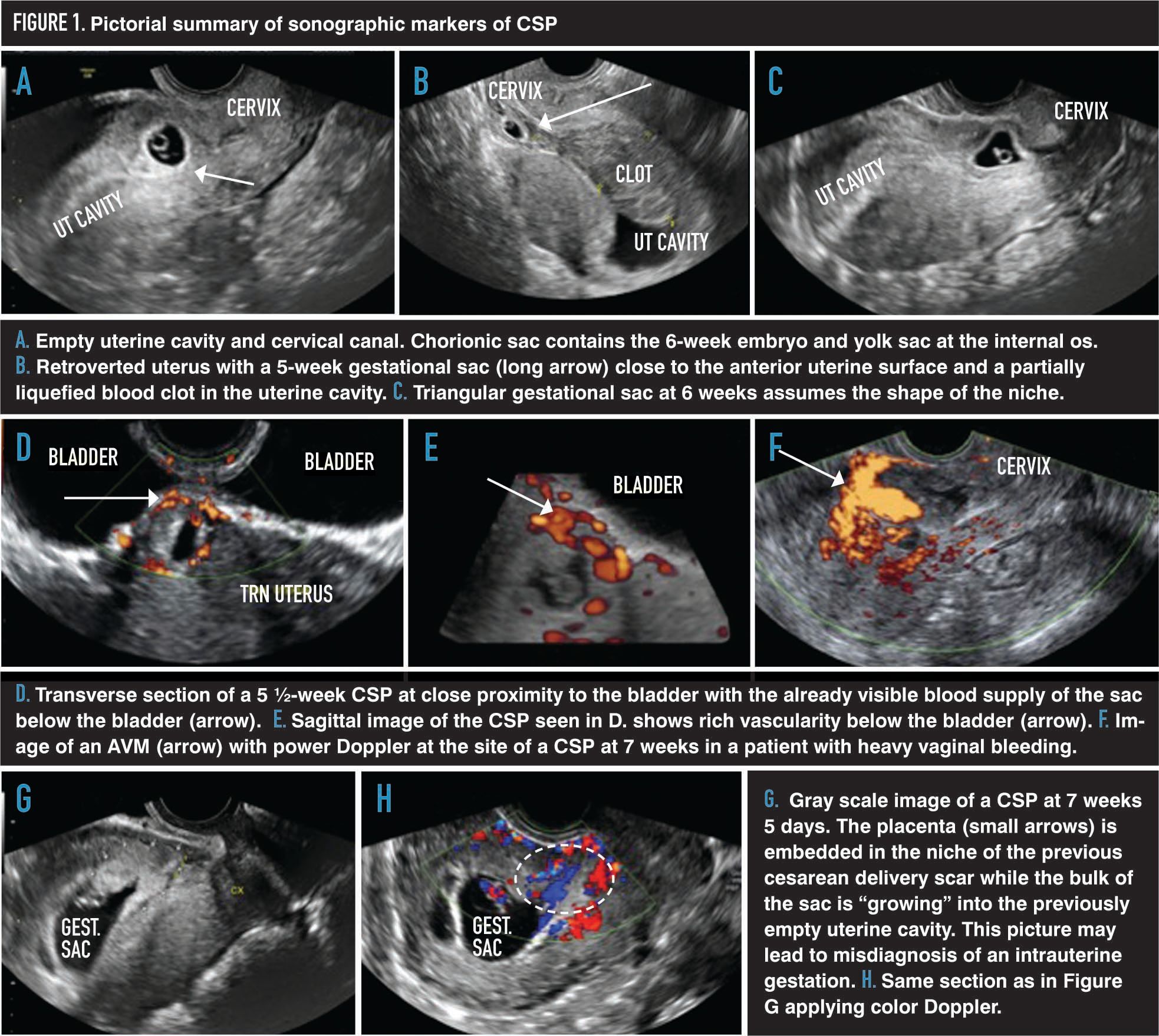
Differential diagnosis
The differential diagnosis includes a cervical pregnancy, or a miscarriage in progress. A cervical pregnancy is extremely rare in patients with previous cesarean delivery. In more than 50 years of practice, the authors have seen only one case. Therefore, the differential diagnosis of a cervical pregnancy is mainly in patients with no history of cesarean delivery. Figure 2 demonstrates a simple method of distinguishing between a true CSP and an intrauterine pregnancy (IUP) which is reliable at sac sizes of 5–6 mm in diameter or approximately 5–6 postmenstrual weeks. A better pregnancy outcome is thought to occur if the placenta implants “on the scar” rather than “in a niche” (Figure 3). (“On the scar” means that there is a millimeters-thick scar or myometrium on which the tiny placenta implants. “In the niche” means that there is no myometrium or scar tissue between the placenta and the uterine serosa or the bladder.1)
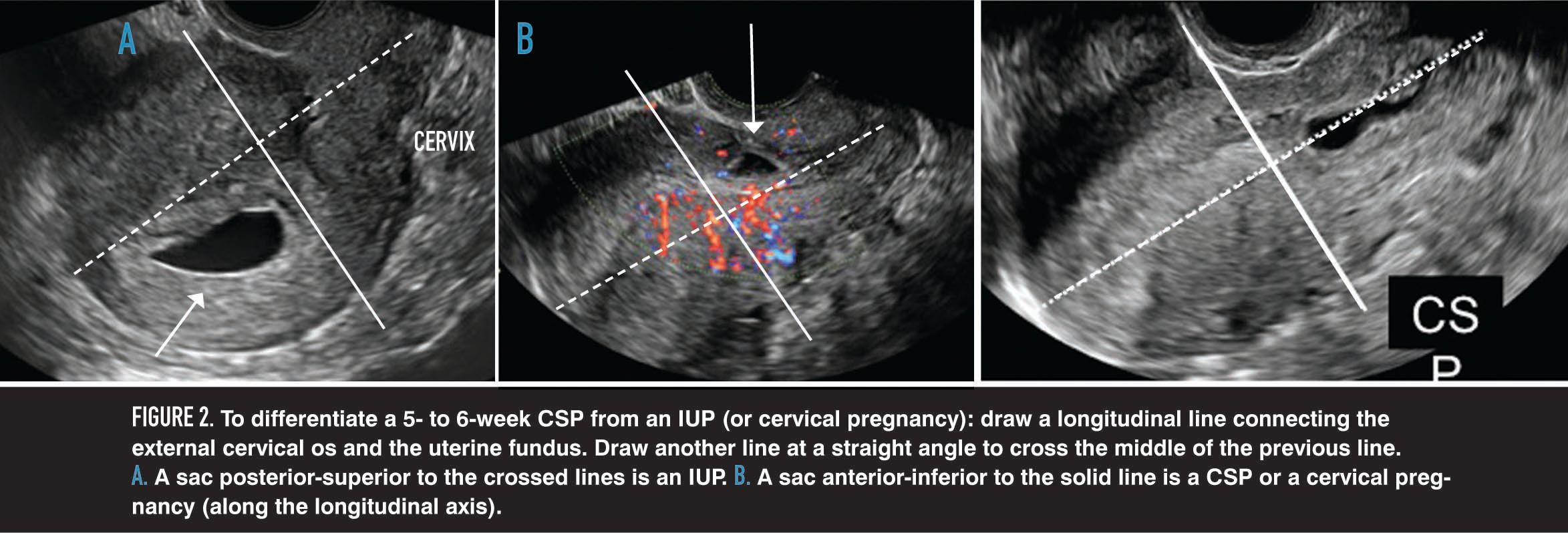
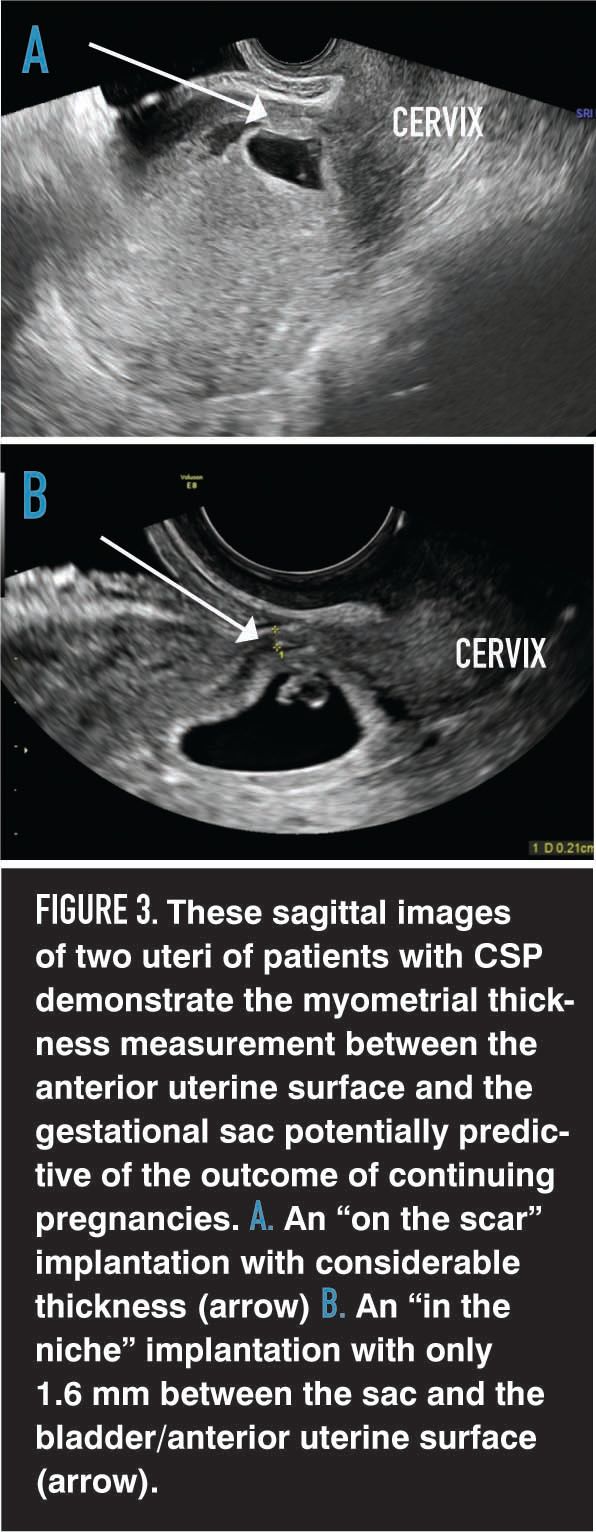
Connection between CSP and MAP?
Several articles document the connection between CSP and MAP, stressing their identical histology.1,12-14 Patients should be counseled that continuing a CSP will likely result in a MAP in the third trimester. This information, together with counseling about the risks, allows them to choose between early termination or continuation of the pregnancy.12,13
Recurrent, multifetal, and heterotopic CSP
The risk of a recurrent CSP is estimated to be about 1%.5,15 Rarely, twin gestational sacs with 2 live embryos can be seen in a CSP. Accounts of several heterotopic IUPs and CSP have been published, mostly following use of assisted reproductive technology14,16 (Figure 4).
NEXT: Counseling CSP patients
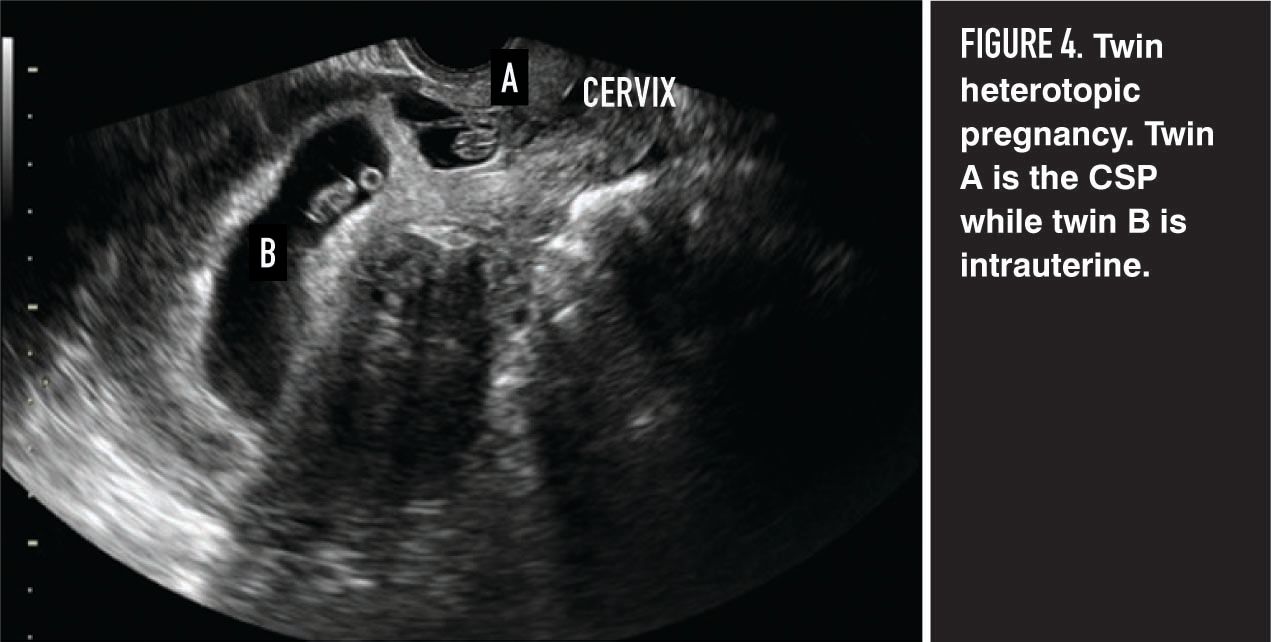
Counseling CSP patients
The first step is to determine if fetal heart activity is seen.
A. If no yolk sac and/or no embryo and/or no cardiac activity are seen, reexamine every 2–3 days. If there is still no documented heart activity and no yolk sac and/or embryo, ultrasound and biochemical follow-up is sufficient until the serum hCG value returns to zero. Administering intramuscular (IM) MTX (even if no heart activity is observed) may be a reasonable consideration.
B. If there is positive fetal cardiac activity, there are 2 options: termination and continuation of the pregnancy. This requires immediate and decisive action before further growth of the embryo occurs. If a patient decides to continue her pregnancy, the physician should be sure she has an understanding of the significant risks of hemorrhage and uterine rupture, the need for a repeat cesarean delivery, the risk of a MAP, and the common requirement for puerperal hysterectomy.
Managing CSP
Treatment should be individualized, based on a patient’s age, number of previous cesarean deliveries, number of children, and the expertise of the clinicians managing her care. Our guidelines for counseling a patient with a CSP are shown in Figure 5.
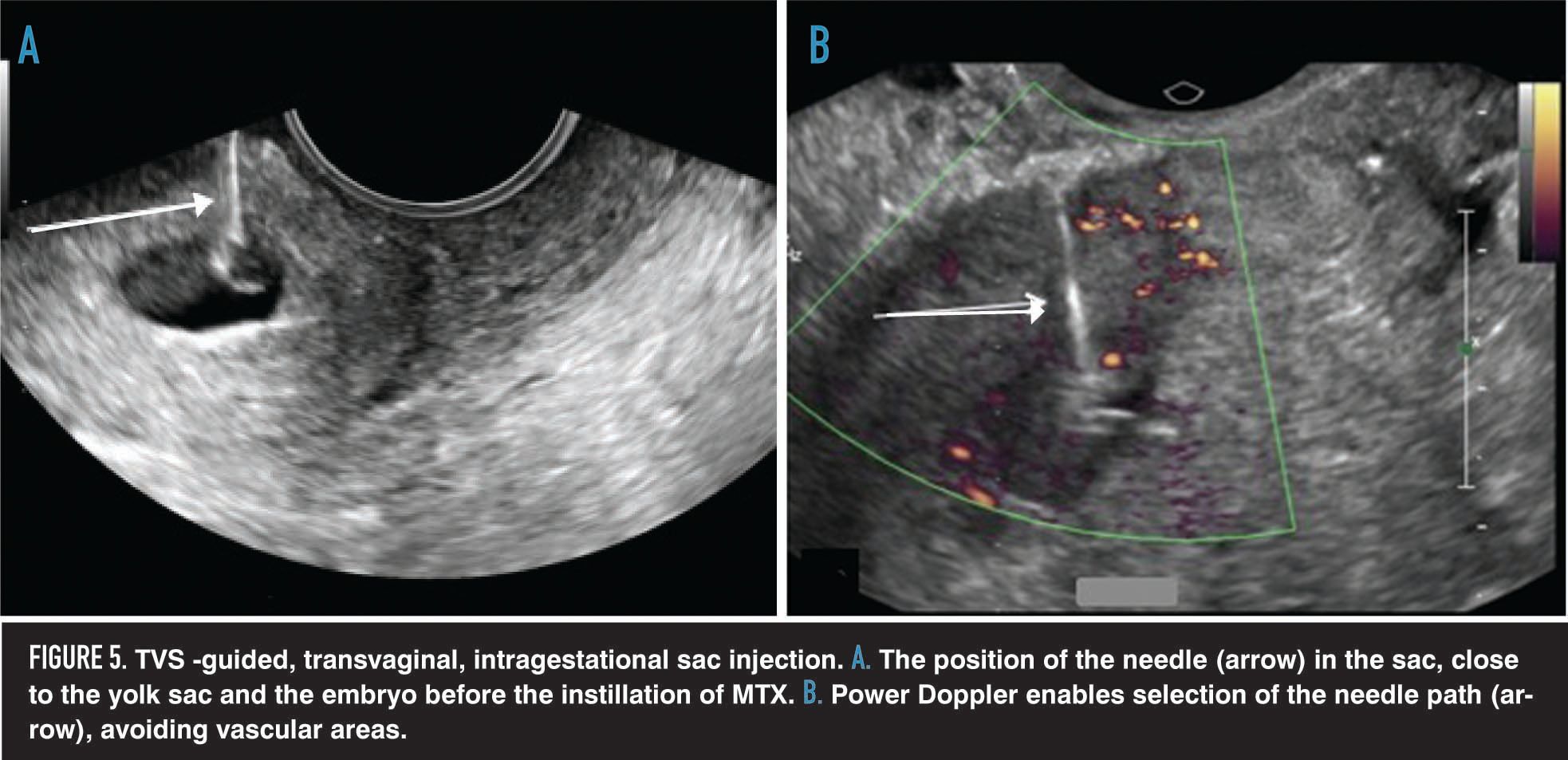
The following treatments for CSP have been suggested:
a. Major surgical approaches, usually under general anesthesia, such as: laparotomy (hysterectomy or local excision), excision by laparoscopy, hysteroscopy or by transvaginal surgery, sharp or blunt D&C, suction aspiration without dilatation of the cervix, or excision performed by the vaginal route. The last 2 can be guided by continuous, real-time ultrasound.
b. Minimally invasive surgery: local intragestational injection of MTX, KCl, or vasopressin.
c. Systemic medication as single or repeated doses of MTX and etoposide.
d. UAE.
e. A combination of treatments used simultaneously or sequentially.
f. Adjuvant measures such as Foley balloon placement and inflation to prevent and/or control bleeding following treatments.
Detailed accounts of these approaches are available in the literature.5
D&C or suction aspiration alone or in combination
The first, traditional choice of gynecologists is to perform a D&C, which is fraught with the most complications because it exposes vessels to injury, leading to potentially severe hemorrhage.5 Some reports advocate the safe use of blunt sac aspiration, however, all cases discussed were combined, followed, or preceded by other treatment methods.17
Methotrexate
The most frequently used medical treatment for CSP is MTX therapy.5
A. Systemic, “first-line,” single-IM-dose MTX using 1 mg/kg of body weight or 50 mg/m2 of body surface area. Its slow action or failure to stop cardiac activity requires second-line treatment, because during the days of waiting, the embryo or fetus and its vascularity can grow. As a result of a later secondary treatment, two-thirds of treated patients encounter complications.18
B. Systemic, sequential, multidose use of MTX. The above-mentioned doses are injected at intervals of 2 or 3 days. The cumulative doses may affect the liver and bone marrow. While multi-dose treatments have failed,19 several authors support systemic multidose MTX treatment.20
C. Intra-arterial or intravenous MTX treatment has been used in China21-23 and can be used at the time of UAE.
NEXT: Surgical excision
Surgical excision
A. Hysteroscopic excision has been used alone or with other treatments in 113 cases with a reasonably low complication rate of 18.4%, in comparison to other treatment methods.4 It is often combined with laparoscopy.24-29
B. Excision by laparoscopic guidance can be used as a “stand-alone” or in-combination treatment, however, 15 of 49 cases (30.6%) in the literature published before 2013 involved complications. It was used in 94 cases published after 2011,17,26,27,29-33 and only 7.7% of the complications occurred when hysteroscopy and laparoscopy were combined. The small numbers may not allow meaningful evaluation of the last 2 approaches.
C. Excision by laparotomy. Reports exist of approximately 15 patients undergoing excision of the gestational sac via laparotomy.27,29,34,35
D. Elective hysterectomy was performed to treat bleeding complications.23,36-38
E. Transvaginal surgical excision was used electively in 119 patients with a low (9.7%) complication rate.39-41
Intragestational-sac injection of MTX or potassium chloride, with continuous, real-time ultrasound guidance
While this is the least-known and least-used treatment, its advantages include the absence of an anesthetic requirement, the fewest and least-involved complications, and its ability to be combined with other treatments such as UAE, systemic MTX, and inflation of an intrauterine Foley balloon catheter to prevent or treat eventual hemorrhage. Of 83 cases injected transvaginally only 9 (10.8%) had complications. Transabdominal sonographic guidance had a slightly higher complication rate (15%). Since 2012, the authors have used ethanol, MTX, and potassium chloride (KCI) in 53 patients19,26,42-46 with a complication rate of 5.8%. Some providers prefer the local use of KCl for all types of ectopic pregnancy including CSP.46 KCl is exclusively used to inject heterotopic CSP. Local, intragestational sac injections are definitive treatment of CSP, as this procedure stops cardiac activity “on the spot” and is likely the most effective and simple intervention for CSPs between 6 and 8 weeks’ gestation (Figure 6). This treatment should be considered if patients desire future fertility.
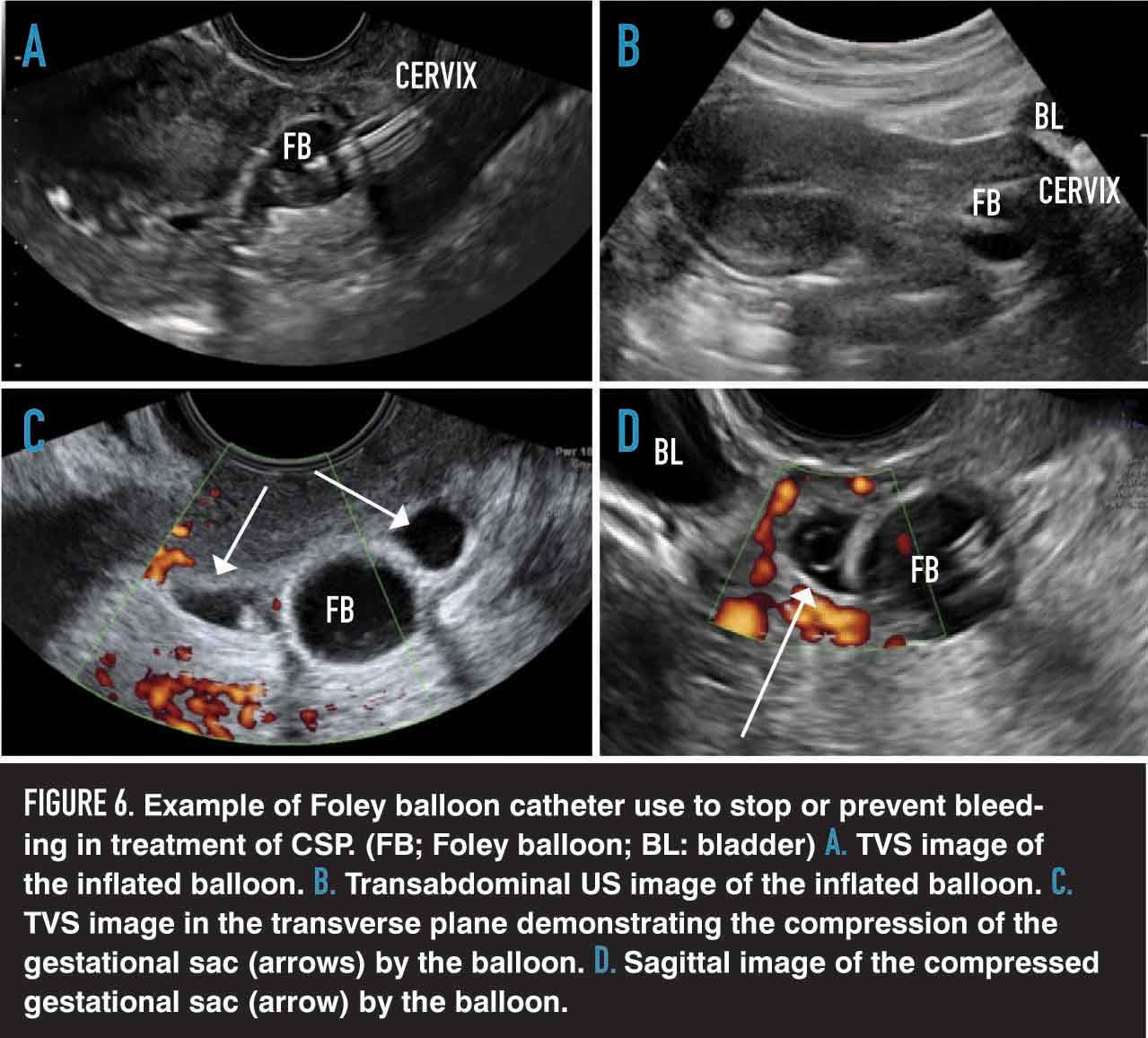
UAE
If used as a primary and solitary treatment, UAE has a complication rate of 47% among the 64 cases described in a review of 751 CSP cases.5 However, in 78 patients, UAE was combined with other noninvasive and invasive treatments, resulting in better success with fewer complications.31,47,48 In our 60 cases of CSP, UAE was used as a rescue treatment in 4 patients who experienced persistent vaginal bleeding or developed AVM.49
NEXT: Lessons from a case presentation
Foley balloon catheters
Inserting and inflating a Foley balloon catheter at the site of the CSP, blocked with 5 to 30 mL is a new and potentially extremely useful adjunct treatment approach.50-53 Catheters can be kept in situ for as long as 3–4 days with antibiotic coverage.
Lessons from the case presentation
1. The radiologist should have performed TVS to confirm the diagnosis of CSP.
2. The resident misdiagnosed the case as an intrauterine pregnancy despite the suggestion of the radiologist of scar pregnancy, which led to an inappropriate simple D&C as the first step.
3. The team did not use the Foley balloon catheter correctly. It must be inflated under real-time ultrasound guidance and close to the scar pregnancy, not high in the uterine cavity.
4. Sharp D&C was performed not once but twice, exacerbating bleeding.
5. A second transvaginal scan also missed the diagnosis of CSP.
6. During laparotomy the possibility of an excision and repair could have been considered.
7. The possibility of an emergency UAE could have been considered after the first D&C, with correct placement of a Foley balloon catheter as a palliative measure to control bleeding until UAE was effective.
Summary
Although relatively rare, CSP is a dangerous and a complication-ridden consequence of cesarean delivery. Cesarean scar pregnancy is not an ectopic pregnancy by definition. Compared to “actual” ectopic pregnancies, the CSP is in the uterine cavity, and unlike true ectopic gestations, if not terminated, it can result in a live offspring.12,13 Transvaginal sonography and color Doppler ultrasound are the best diagnostic tools for its detection, and if needed, for treatment as well. A low, anteriorly displaced gestational sac in a pregnancy with a history of previous cesarean delivery is almost certainly a CSP. Location of the placenta and its vessels by color Doppler determines the implantation site. Its differential diagnoses include cervical pregnancy and miscarriage in progress. Patients diagnosed with CSP in the first trimester should be counseled based upon new, peer-reviewed data describing the possible second- and third-trimester complications such as MAP with its possible consequences.
The authors strongly believe that the mounting anecdotal evidence supports instituting a simple, relatively inexpensive very early transvaginal screening ultrasound of every pregnant patient with a previous history of cesarean delivery.1,54 There is no single best treatment to terminate a CSP with positive heart activity. Therefore, a procedure with the least complications should be selected and administered promptly. By contrast, sharp curetting of the CSP site can cause severe bleeding. Single-dose systemic MTX has questionable effect as first-line therapy and delays the final treatment. However, as an adjuvant to other treatments, it has proven efficacy. UAE is a useful adjunct to other therapies.
Treatment to stop heart activity has low complication rates. Insertion and inflation of a Foley balloon catheter is effective to prevent or treat bleeding from the site of a CSP following local injection or endoscopic treatment of CSP. Finally, physicians should be aware of the possibility of rare, but possible, recurrent CSP.

References
1. Comstock CH, Bronsteen RA. The antenatal diagnosis of placenta accrete. BJOG. 2014;121:171-181; discussion 181-182.
2. Hamilton BE, Martin JA, Ventura SJ. Births: preliminary data for 2012. Natl Vital Stat Rep. 2013;62:1–20.
3. Spong CY, Berghella V, Wenstrom KD, Mercer BM, Saade GR. Preventing the first cesarean delivery: summary of a joint Eunice Kennedy Shriver National Institute of Child Health and Human Development, Society for Maternal-Fetal Medicine, and American College of Obstetricians and Gynecologists Workshop. Obstet Gynecol. 2012;120:1181–1193.
4. Hamilton BE, Hoyert DL, Martin JA, Strobino DM, Guyer B. Annual summary of vital statistics: 2010-2011. Pediatrics. 2013;131:548–558.
5. Timor-Tritsch IE, Monteagudo A. Unforeseen consequences of the increasing rate of cesarean deliveries: early placenta accreta and cesarean scar pregnancy. A review. Am J Obstet Gynecol. 2012;207:14–29.
6. Jauniaux E, Jurkovic D. Placenta accreta: pathogenesis of a 20th century iatrogenic uterine disease. Placenta. 2012;33:244–251.
7. Jurkovic D, Hillaby K, Woelfer B, Lawrence A, Salim R, Elson CJ. Cesarean scar pregnancy. Ultrasound Obstet Gynecol. 2003;21:310.
8. Jurkovic D, Hillaby K, Woelfer B, Lawrence A, Salim R, Elson CJ. First-trimester diagnosis and management of pregnancies implanted into the lower uterine segment Cesarean section scar. Ultrasound Obstet Gynecol. 2003;21:220–227.
9. Rotas MA, Haberman S, Levgur M. Cesarean scar ectopic pregnancies: etiology, diagnosis, and management. Obstet Gynecol. 2006;107:1373–1381.
10. Seow KM, Hwang JL, Tsai YL, Huang LW, Lin YH, Hsieh BC. Subsequent pregnancy outcome after conservative treatment of a previous cesarean scar pregnancy. Acta Obstet Gynecol Scand. 2004;83:1167–1172.
11. Timor-Tritsch IE, Monteagudo A, Santos R, Tsymbal T, Pineda G, Arslan AA. The diagnosis, treatment, and follow-up of cesarean scar pregnancy. Am J Obstet Gynecol. 2012;207:44.e1–e13.
12. Ballas J, Pretorius D, Hull AD, Resnik R, Ramos GA. Identifying sonographic markers for placenta accreta in the first trimester. J Ultrasound Med. 2012;31:1835–1841.
13. Timor-Tritsch IE, Monteagudo A, Cali G, et al. Cesarean scar pregnancy is a precursor of morbidly adherent placenta. Ultrasound Obstet Gynecol. 2014:[published online ahead of print June 4, 2014].
14. Wang CJ, Tsai F, Chen C, Chao A. Hysteroscopic management of heterotopic cesarean scar pregnancy. Fertil Steril. 2010;94:1529.e15–18.
15. Gupta S, Pineda G, Rubin S, Timor-Tritsch IE. Four consecutive recurrent cesarean scar pregnancies in a single patient. J Ultrasound Med. 2013;32:1878–1880.
16. Demirel LC, Bodur H, Selam B, Lembet A, Ergin T. Laparoscopic management of heterotopic cesarean scar pregnancy with preservation of intrauterine gestation and delivery at term: case report. Fertil Steril. 2009;91:1293.e5–7.
17. Li JB, Kong LZ, Fan L, Fu J, Chen SQ, Yao SZ. Transvaginal surgical management of cesarean scar pregnancy: analysis of 49 cases from one tertiary care center. Eur J Obstet Gynecol Reprod Biol. 2014;182C:102–106.
18. Yin XH, Yang SZ, Wang ZQ, Jia HY, Shi M. Injection of MTX for the treatment of cesarean scar pregnancy: comparison between different methods. Int J Clin Exp Med. 2014;7:1867–1872.
19. Berhie SH, Molina RL, Davis MR, Anchan RM, Wang KC. Beware the scar: Laparoscopic hysterectomy for 7-week cesarean delivery scar implantation pregnancy. Am J Obstet Gynecol. 2015;212(2):247.e1–2.
20. Kutuk MS, Uysal G, Dolanbay M, Ozgun MT. Successful medical treatment of cesarean scar ectopic pregnancies with systemic multidose methotrexate: single-center experience. J Obstet Gynaecol Res. 2014;40:1700–1706.
21. Li C, Feng D, Jia C, Liu B, Zhan X. Transcatheter arterial chemoembolization versus systemic methotrexate for the management of cesarean scar pregnancy. Int J Gynaecol Obstet. 2011;113:178–182.
22. Zhang J, Troendle J, Reddy UM, et al. Contemporary cesarean delivery practice in the United States. Am J Obstet Gynecol. 2010;203:326.e1–e10.
23. An X, Ming X, Li K, Wang J. The analysis of efficacy and failure factors of uterine artery methotrexate infusion and embolization in treatment of cesarean scar pregnancy. ScientificWorldJournal. 2013;2013:213603.
24. Fylstra DL. Cervical pregnancy: 13 cases treated with suction curettage and balloon tamponade. Am J Obstet Gynecol. 2014;210:581.e1–5.
25. Mollo A, Alviggi C, Conforti A, Insabato L, De Placido G. Intact removal of spontaneous twin ectopic Caesarean scar pregnancy by office hysteroscopy: case report and literature review. Reprod Biomed Online. 2014;29:530–533.
26. Shao MJ, Hu MX, Xu XJ, Zhang L, Hu M. Management of caesarean scar pregnancies using an intrauterine or abdominal approach based on the myometrial thickness between the gestational mass and the bladder wall. Gynecol Obstet Invest. 2013;76:151–157.
27. Wang G, Liu X, Bi F, et al. Evaluation of the efficacy of laparoscopic resection for the management of exogenous cesarean scar pregnancy. Fertil Steril. 2014;101:1501–1507.
28. Zhang Y, Chen YS, Wang JJ, Lu ZY, Hua KQ. [Analysis of 96 cases with cesarean scar pregnancy]. Zhonghua Fu Chan Ke Za Zhi. 2010;45:664–668.
29. Li Y, Xiang Y, Wan X, Feng F, Ren T. [Clinical study on 39 cases with caesarean scar pregnancy with sonographic mass]. Zhonghua Fu Chan Ke Za Zhi. 2014;49:10–13.
30. Wang YL, Weng SS, Huang WC, Su TH. Laparoscopic management of ectopic pregnancies in unusual locations. Taiwan J Obstet Gynecol. 2014;53:466–470.
31. Wu X, Xue X, Wu X, et al. Combined laparoscopy and hysteroscopy vs. uterine curettage in the uterine artery embolization-based management of cesarean scar pregnancy: a cohort study. Int J Clin Exp Med. 2014;7:2793–2803.
32. He Y, Wu X, Zhu Q, et al. Combined laparoscopy and hysteroscopy vs. uterine curettage in the uterine artery embolization-based management of cesarean scar pregnancy: a retrospective cohort study. BMC Womens Health. 2014;14:116.
33. Jiang S, Zhao S. Laparoscopic surgery for ectopic pregnancy within a cesarean scar. Clin Exp Obstet Gynecol. 2013;40:440–444.
34. Abdelkader MA, Fouad R, Gebril AH, El Far MA, Elyassergi DF. Caesarean scar pregnancy: hysterotomy is rapid and safe management option. Arch Gynecol Obstet. 2014;290:381–383.
35. Kai K, Shimamoto K, Matsumoto H, Narahara H. Conservative surgical treatment for caesarean scar pregnancy. J Obstet Gynaecol. 2014;34:91–92.
36. Nankali A, Ataee M, Shahlazadeh H, Daeichin S. Surgical management of the cesarean scar ectopic pregnancy: a case report. Case Rep Obstet Gynecol. 2013;2013:525187.
37. Sorbi F, Sisti G, Pieralli A, et al. Cervicoisthmic choriocarcinoma mimicking cesarean section scar ectopic pregnancy. J Res Med Sci. 2013;18:914–917.
38. Wozniak S, Pyra K, Kludka-Sternik M, et al. Uterine artery embolization using gelatin sponge particles performed due to massive vaginal bleeding caused by ectopic pregnancy within a cesarean scar: a case study. Ginekol Pol. 2013;84:966–969.
39. Shi J, Qin J, Wang W, Zhang H. [Clinical study on 57 cases with caesarean scar pregnancy]. Zhonghua Fu Chan Ke Za Zhi. 2014;49:18–21.
40. Wang DB, Chen YH, Zhang ZF, et al. Evaluation of the transvaginal resection of low-segment cesarean scar ectopic pregnancies. Fertil Steril. 2014;101:602–606.
41. Wang Z, Shan L, Xiong H. Transvaginal removal of ectopic pregnancy tissue and repair of uterine defect for cesarean scar pregnancy. Clin Exp Obstet Gynecol. 2013;40:546–547.
42. Nguyen-Xuan HT, Lousquy R, Barranger E. [Diagnosis, treatment, and follow-up of cesarean scar pregnancy]. Gynecol Obstet Fertil. 2014;42:483–489.
43. Pang YP, Tan WC, Yong TT, Koh PK, Tan HK, Ho TH. Caesarean section scar pregnancy: a case series at a single tertiary centre. Singapore Med J. 2012;53:638–642.
44. Seow KM, Wang PH, Huang LW, Hwang JL. Transvaginal sono-guided aspiration of gestational sac concurrent with a local methotrexate injection for the treatment of unruptured cesarean scar pregnancy. Arch Gynecol Obstet. 2013;288:361–366.
45. Yamaguchi M, Honda R, Uchino K, Tashiro H, Ohba T, Katabuchi H. Transvaginal methotrexate injection for the treatment of cesarean scar pregnancy: efficacy and subsequent fecundity. J Minim Invasive Gynecol. 2014;21:877–883.
46. Doubilet PM, Benson CB, Frates MC, Ginsburg E. Sonographically guided minimally invasive treatment of unusual ectopic pregnancies. J Ultrasound Med. 2004;23:359–370.
47. Cao S, Zhu L, Jin L, Gao J, Chen C. Uterine artery embolization in cesarean scar pregnancy: safe and effective intervention. Chin Med J (Engl). 2014;127:2322–2326.
48. Gao L, Huang Z, Gao J, Mai H, Zhang Y, Wang X. Uterine artery embolization followed by dilation and curettage within 24hours compared with systemic methotrexate for cesarean scar pregnancy. Int J Gynaecol Obstet. 2014;127:147–151.
49. Timor-Tritsch IE, Khatib N, Monteagudo A, Ramos J, Berg R, Kovacs S. Cesarean scar pregnancy (CSP): experience of 60 cases. J Ultrasound Med. 2015;34(4):601–610.
50. Jiang T, Liu G, Huang L, Ma H, Zhang S. Methotrexate therapy followed by suction curettage followed by Foley tamponade for caesarean scar pregnancy. Eur J Obstet Gynecol Reprod Biol. 2011;156:209–211.
51. Atilgan R, Celik A, Boztosun A, Ilter E, Yalta T, Ozercan R. Evaluation of cervical cytological abnormalities in Turkish population. Indian J Pathol Microbiol. 2012;55:52–55.
52. Tsui KH, Lin LT, Yu KJ, et al. Double-balloon cervical ripening catheter works well as an intrauterine balloon tamponade in post-abortion massive hemorrhage. Taiwan J Obstet Gynecol. 2012;51:426–429.
53. Shao HJ, Ma JT, Yang XE, Xu LP, Yang CL. [Diagnosis and treatment of cesarean scar pregnancy]. Zhonghua Yi Xue Za Zhi. 2010;90:2616–2619.
54. Stirnemann JJ, Chalouhi GE, Forner S, et al. First-trimester uterine scar assessment by transvaginal ultrasound. Am J Obstet Gynecol. 2011;205(6):551.e1–6.
S4E1: New RNA platform can predict pregnancy complications
February 11th 2022In this episode of Pap Talk, Contemporary OB/GYN® sat down with Maneesh Jain, CEO of Mirvie, and Michal Elovitz, MD, chief medical advisor at Mirvie, a new RNA platform that is able to predict pregnancy complications by revealing the biology of each pregnancy. They discussed recently published data regarding the platform's ability to predict preeclampsia and preterm birth.
Listen
